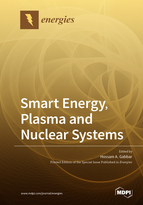Smart Energy, Plasma and Nuclear Systems
A special issue of Energies (ISSN 1996-1073). This special issue belongs to the section "A: Sustainable Energy".
Deadline for manuscript submissions: closed (1 April 2020) | Viewed by 15265
Special Issue Editor
Interests: resilient smart energy grids and micro-energy grids planning, control, and protection; advanced plasma generation and application on fusion energy; advanced safety and control systems for nuclear power plants; safety engineering, fault diagnosis, and real-time simulation; risk-based energy conservation; smart green buildings; process systems engineering of the energy and nuclear facilities, and oil and gas production plants
Special Issues, Collections and Topics in MDPI journals
Special Issue Information
Dear Colleagues,
The 7th International Conference on Smart Energy Grid Engineering (SEGE 2019) (http://www.sege-conference.com/) will take place at UOIT, Oshawa, Canada, 12–14 August 2019.
The SEGE conference aims at providing an opportunity to discuss various engineering challenges of smart energy grid design and operation by focusing on advanced methods and practices for designing different components and their integration within the grid. It also provides a forum for researchers from academia and professionals from industry, as well as government regulators, to tackle these challenges and discuss and exchange knowledge and best practices about design and the implementation of smart energy grids.
The Symposium on Plasma and Nuclear Systems (SPANS 2019) is connected with SEGE 2019 and will be held on 15 August 2019.
SPANS is providing a forum for researchers from academia and industry to present and discuss the latest research innovations in nuclear and plasma systems. SPANS will provide attendees with state-of-the-art research and technologies and engage in active discussions with industry. Additionally, it will provide industry with opportunities to promote their products and business cases. Attendees from regulators and standards will engage in fruitful discussions on how R&D is linked with regulations and standards.
Authors of papers related to energies presented at the conferences are invited to submit extended versions of their work to the Special Issue for publication.
Prof. Dr. Hossam A. Gabbar
Guest Editor
Manuscript Submission Information
Manuscripts should be submitted online at www.mdpi.com by registering and logging in to this website. Once you are registered, click here to go to the submission form. Manuscripts can be submitted until the deadline. All submissions that pass pre-check are peer-reviewed. Accepted papers will be published continuously in the journal (as soon as accepted) and will be listed together on the special issue website. Research articles, review articles as well as short communications are invited. For planned papers, a title and short abstract (about 100 words) can be sent to the Editorial Office for announcement on this website.
Submitted manuscripts should not have been published previously, nor be under consideration for publication elsewhere (except conference proceedings papers). All manuscripts are thoroughly refereed through a single-blind peer-review process. A guide for authors and other relevant information for submission of manuscripts is available on the Instructions for Authors page. Energies is an international peer-reviewed open access semimonthly journal published by MDPI.
Please visit the Instructions for Authors page before submitting a manuscript. The Article Processing Charge (APC) for publication in this open access journal is 2600 CHF (Swiss Francs). Submitted papers should be well formatted and use good English. Authors may use MDPI's English editing service prior to publication or during author revisions.
Keywords
- Smart energy grids
- Energy efficiency
- Clean energy
- Renewable energy






